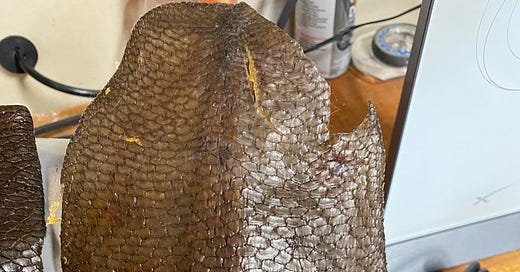One of the things that I pride myself on is learning to leverage every part of an animal that I take through trapping or hunting. Beaver are no different and the animal itself offers many different uses. The mountain men of old knew this and would trap beaver in order to resell their pelts, use the castoreum glands for perfumes and lure, and would often eat the fat-laden tails to get some much needed fat and vitamins while traversing the back country.
Though I have eaten a beaver tail before (side note: nothing can transport you back to the ways of the wild west quite like eating a beaver tail over open flame deep in the woods) I have found that there are more practical uses for their scaly skin.
This past season I decided to tan my beaver tails and save the leather for use in home made wallets and watch bands. To get started, I carefully took some of my beaver tails and split them in half across their horizontal plane with a sharp knife.
That knife work leaves you with two halves, one of which will have a bone still attached to it. The job now is to remove the bone and all fat from both sides without poking through the scales... This took me several hours to do for four tails as the fat and cartilage were quite stubborn. Once split and fleshed I followed the same process as most of my other tanning pursuits and salted the flesh side of each tail for 48 hours.
After two helpings of salt (scraping and re-applying at the 24 hour mark) I took the now drier tails and removed any other remaining fat that I missed. Then, just like our snakeskins, I let the beaver tails soak in a 1:1 mixture of vegetable glycerin and 90%+ rubbing alcohol for several days.
The output was a pliable and tanned leather which is ready to be used for any number of crafts including wallets and watch bands, which I will cover in a later post.




